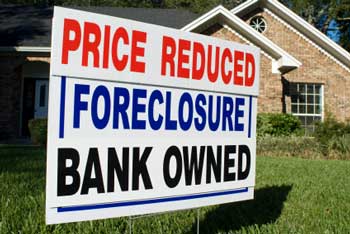Foreclosure filings dropped again in July, marking the 10th straight month for year-over-year declines and reaching their lowest level since November 2007, RealtyTrac reports. But analysts are still mostly attributing the drop to banks’ processing delays as they take more time to take action against delinquent home owners.
For July, about 212,764 homes received a foreclosure filing — which is a notice of default or auction sale or completed foreclosure — that’s down 4 percent compared to June. Filings were 35 percent lower than July 2010, according to RealtyTrac, and bank repossessions were down 33.6 percent from its peak in September 2010. Also, initial notices of default dropped 39 percent year-over-year to fewer than 60,000, which could be an indication that fewer borrowers are falling behind on their mortgage payments or that lenders are not filing notices as promptly in the past.
“The downward trend in foreclosure activity has now taken on a life of its own,” says RealtyTrac CEO James Saccacio. “It appears that processing delays, combined with the smorgasbord of national and state-level foreclosure prevention efforts, may be allowing more distressed home owners to stave off foreclosure.”
Las Vegas continued to have the highest rate of foreclosures in the country — a filing for every 99 homes. Overall, for states, Nevada had the highest foreclosure rate of any state (one filing for every 115 homes), followed by California (one in every 239 homes), and Arizona (one in every 273 homes).
Source: “Foreclosure Filings Fall for 10th Straight Month,” CNNMoney (Aug. 11, 2011)
For all your real estate needs
Call or email
John J. O’Dell® GRI
Real Estate Broker
O’Dell Realty
(530) 263-1091
jodell@nevadacounty.com

The price of a short sale may be slightly lower than mraket value but is not going to be 50% less.Usually a short sale is authorized by the lender when it is expected that the homeowner is insolvent, will not make future payments, it will be unlikely to get a deficiency judgment against the owner, and the lender expects the short sale to be approved by the investors. It has the advantage of eliminating the costs of foreclosure and keeping the house in good condition while the process of the sale is under way. Generally when a short sale is completed, the original owners debts to the lender is wiped clean.In many cases, mortgages on a home are not funded by the lender (lender is only a servicing agent) but instead by a group of investors (may be many). If a home is foreclosed, the home is auctioned off so it then becomes owned by one investor (may be the bank). When the home is resold to the public, only that investor must be satisfied about the price and terms of the sale.In the case of a short sale, the lender allows the owner to list the home at a price that the lender thinks will be acceptable to the investors. Since the lender has to get the approval of all the investors, usually there can’t be any conditions to the sale (usually must be AS IS and no negotiation on closing costs).When an offer is made and the lender accepts the offer, that is when process really starts. Now the lender will have to get the approval of all the investors. If there is a second mortgage on the home, that complicates the process. If there isn’t any money available for the investors of the second mortgage, they will not approve the sale. Therefore the investors of the first mortgage will have to give up some of their proceeds to satisfy the investors of the second mortgage. If any investor thinks that they can get a better deal by foreclosing, the deal will not be approved.Usually a short sale process takes about 3-6 months but can take even longer. Usually more than 50% of the short sales fall through.References : Was this answer helpful?